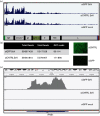Loss of Sendai virus C protein leads to accumulation of RIG-I immunostimulatory defective interfering RNA
- PMID: 28631605
- PMCID: PMC5962894
- DOI: 10.1099/jgv.0.000815
Loss of Sendai virus C protein leads to accumulation of RIG-I immunostimulatory defective interfering RNA
Abstract
Retinoic acid inducible gene (RIG-I)-mediated innate immunity plays a pivotal role in defence against virus infections. Previously we have shown that Sendai virus (SeV) defective interfering (DI) RNA functions as an exclusive and potent RIG-I ligand in DI-RNA-rich SeV-Cantell infected cells. To further understand how RIG-I is activated during SeV infection, we used a different interferon (IFN)-inducing SeV strain, recombinant SeVΔC, which, in contrast to SeV-Cantell is believed to stimulate IFN production due to the lack of the SeV IFN antagonist protein C. Surprisingly, we found that in SevΔC-infected cells, DI RNAs also functioned as an exclusive RIG-I ligand. Infections with wild-type SeV failed to generate any RIG-I-associated immunostimulatory RNA and this correlated with the lack of DI genomes in infected cells, as well as with the absence of cellular innate immune responses. Supplementation of the C protein in the context of SeVΔC infection led to a reduction in the number of DI RNAs, further supporting the potential role of the C protein as a negative regulator of DI generation and/or accumulation. Our findings indicate that limiting DI genome production is an important function of viral IFN antagonist proteins.
Conflict of interest statement
The authors declare that there are no conflicts of interest.
Figures







Similar articles
-
A Single Amino Acid Substitution within the Paramyxovirus Sendai Virus Nucleoprotein Is a Critical Determinant for Production of Interferon-Beta-Inducing Copyback-Type Defective Interfering Genomes.J Virol. 2018 Feb 12;92(5):e02094-17. doi: 10.1128/JVI.02094-17. Print 2018 Mar 1. J Virol. 2018. PMID: 29237838 Free PMC article.
-
Activation of the beta interferon promoter by unnatural Sendai virus infection requires RIG-I and is inhibited by viral C proteins.J Virol. 2007 Nov;81(22):12227-37. doi: 10.1128/JVI.01300-07. Epub 2007 Sep 5. J Virol. 2007. PMID: 17804509 Free PMC article.
-
Identification of a Natural Viral RNA Motif That Optimizes Sensing of Viral RNA by RIG-I.mBio. 2015 Oct 6;6(5):e01265-15. doi: 10.1128/mBio.01265-15. mBio. 2015. PMID: 26443454 Free PMC article.
-
What Really Rigs Up RIG-I?J Innate Immun. 2016;8(5):429-36. doi: 10.1159/000447947. Epub 2016 Jul 21. J Innate Immun. 2016. PMID: 27438016 Free PMC article. Review.
-
Sendai Virus and a Unified Model of Mononegavirus RNA Synthesis.Viruses. 2021 Dec 9;13(12):2466. doi: 10.3390/v13122466. Viruses. 2021. PMID: 34960735 Free PMC article. Review.
Cited by
-
Defective viral genomes are key drivers of the virus-host interaction.Nat Microbiol. 2019 Jul;4(7):1075-1087. doi: 10.1038/s41564-019-0465-y. Epub 2019 Jun 3. Nat Microbiol. 2019. PMID: 31160826 Free PMC article. Review.
-
Type I and Type II Interferon Antagonism Strategies Used by Paramyxoviridae: Previous and New Discoveries, in Comparison.Viruses. 2022 May 21;14(5):1107. doi: 10.3390/v14051107. Viruses. 2022. PMID: 35632848 Free PMC article. Review.
-
Innate Intracellular Antiviral Responses Restrict the Amplification of Defective Virus Genomes of Parainfluenza Virus 5.J Virol. 2020 Jun 16;94(13):e00246-20. doi: 10.1128/JVI.00246-20. Print 2020 Jun 16. J Virol. 2020. PMID: 32295916 Free PMC article.
-
Restriction factor screening identifies RABGAP1L-mediated disruption of endocytosis as a host antiviral defense.Cell Rep. 2022 Mar 22;38(12):110549. doi: 10.1016/j.celrep.2022.110549. Cell Rep. 2022. PMID: 35320721 Free PMC article.
-
Sustained Replication of Synthetic Canine Distemper Virus Defective Genomes In Vitro and In Vivo.mSphere. 2021 Oct 27;6(5):e0053721. doi: 10.1128/mSphere.00537-21. Epub 2021 Sep 22. mSphere. 2021. PMID: 34550005 Free PMC article.
References
MeSH terms
Substances
Grants and funding
LinkOut - more resources
Full Text Sources
Other Literature Sources

